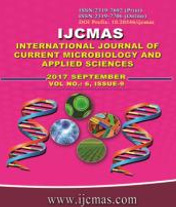


 National Academy of Agricultural Sciences (NAAS)
National Academy of Agricultural Sciences (NAAS)

|
PRINT ISSN : 2319-7692
Online ISSN : 2319-7706 Issues : 12 per year Publisher : Excellent Publishers Email : editorijcmas@gmail.com / submit@ijcmas.com Editor-in-chief: Dr.M.Prakash Index Copernicus ICV 2018: 95.39 NAAS RATING 2020: 5.38 |
Experiments conducted on seasonal incidence of Tetranychus urticae Koch. During the year 2013-2014 at the University Farm of Sher-e-Kashmir University of Agricultural Sciences and Technology-Jammu revealed that the incidence of red spider mite, T. urticae was 14.40 mites/leaf/plant in the 14th standard week and reached its maximum 27.50 mites/leaf/plant in the 12th standard week. The mean maximum and minimum temperatures had positive but highly significant effect on thrips population with ‘r’ values (r = 0.721** and r = 0.768**). The minimum temperature, relative humidity (evening) and rainfall had highly negative significant effect on mite population with ‘r’ value (r = -0.500**, -0.684** and -0.569**), while as maximum temperature and mean relative humidity (morning) had negative effect on the mite population with ‘r’ values (r = -0.014 and -0.219). The relative efficacy of insecticides against T. urticae showed that imidacloprid 200SL (0.0025%) was the most effective in reducing the mite population followed by, dimethoate 30EC (0.05%), carbosulfan 25EC (0.03%) and novaluron 10EC (50g a.i/ha). Neem oil (0.05%) was least effective in controlling mite population on rose.
 |
 |
 |
 |
 |